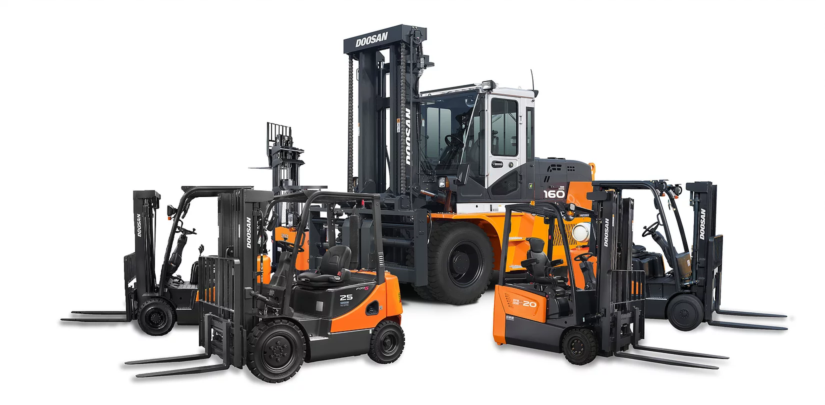AN OVERVIEW OF THE INTERNATIONAL FORKLIFT INDUSTRY
Those of us who were still in High School in the 1980s and 1990s remember learning about the Industrial Revolution as an event that lasted over about 100 years from around 1750 to 1850 that transformed society dramatically as it cascaded throughout the world, precipitating changes in agriculture, manufacturing, mining and transportation. We were told that it all began in Great Britain with the invention of a Watt steam engine.
Today, we have come to realize that since the mid-1800s, there have been multiple industrial revolutions, often precipitated by a single invention, like the telephone, the radio, television, the computer. Whether a precipitator or an accelerator of one of the many recent industrial revolutions, I propose an unsung invention as having been instrumental in the creation of the current technological advances in the industrial world – namely, the ultimate material handling machine – specifically, the forklift.
To illustrate this, we can conduct an exercise that I learned from a forklift dealer….I suggest you play the forklift game. Consider the replacement part for a child’s toy you may have recently received in a delivery on your front porch from Amazon.com. Analyze how many times it may have had an encounter with a forklift during its lifetime from being pliable raw material to its arrival at your door. If it is wooden, it may have had several such encounters in the forest of its origin until it was fully processed and delivered to the manufacturer where it would be turned into the part for the product it would enhance. During that cycle, it might have been painted, and attached to the larger item of which it is a part by a staple, screw, glue or nail, all of which went through their own cycles encountering forklifts before it arrived at the manufacturer. During the various phases of it creation into a final product, it would have been moved or stacked by a forklift. Its packaging would have gone through its own creative, storage and delivery cycles – with forklifts involved. Preparation for storage and shipping to a distributor involved forklifts. Whether it ends up at a retailer or on a FedEx truck, chances are forklifts were used in the process. A recent calculation indicates that our little replacement part encountered between 15 and 21 forklifts on the way to your front porch.
Another way of looking at the number of new or used forklifts being used in society today is to consider China, where the majority of consumer products are manufactured. According to www.reportlinker.com, a ResearchInChina industry report issued in 2012 reports that China is playing an increasingly prominent role in the global forklift market. Since it became the world’s first largest forklift sales market in 2009, China has been ranking No. 1 in sales volume of forklifts which has constituted around a quarter of the global total. The global forklift industry hit a record high in 2011 with order quantity rising 23% and sales volume rising 27% over the previous year. The total sales volume of forklifts broke 200,000 units in 2010 and 300,000 units in 2011, reaching a historic high.
The electric warehouse forklift emerges as the most prominent product in the mix of models. In 2011, the sales volume of electric warehouse forklifts (including electric ride-on warehouse forklift and electric walking warehouse forklift) soared by 78.53% to a record 53,171 units.
The Global Forklift Industry
The average consumer is unaware of the role played by the forklift in the world economy. The number of manufacturers of forklifts alone is an eye-opener. There are numerous relatively small forklift companies in the world, but for our purposes in analyzing the industry, we can focus on the top twenty companies based on sales volume. An interesting exercise would be to have Ancestry.com do a family tree of the major material handling companies. Because of mergers, buy outs, collaboration agreements, acquisitions and consolidations, a family tree of forklift companies looks like a history of arranged marriages, ugly divorces and pragmatic unions. Just as enlightening is how companies evolved from the manufacture of a totally unrelated product line into a forklift operation. For instance, the Yale Materials Handling Corporation began as the highly visible and successful Yale Lock Company. More logically, Cat Forklifts are “stepchildren” of the famous Caterpillar earth moving industry leader. The Japanese Forklift leader, Komatsu, Ltd., started as a Mining company. In some of these cases, the company gravitated to the design and development of forklifts as a practical response to the need to move and store their products. Linde Material Handling North America began as a Wagon Repair Company dating back to 1853. Its parent German company was founded in Hamburg by a refrigeration engineer named Dr. Carl von Linde. Two of the major forklift companies are related directly to the auto industry, namely Toyota and Nissan.
It is hard to discover a single “inventor” of the forklift, because the years given as the beginning of the forklift operations within a company are the same in different companies in different parts of the world, causing it to appear that spontaneous combustion was the method by which forklifts burst onto the world scene. Also, with so many versions of early material handling equipment, it is hard to say exactly what item deserves the label: “forklift.” The inventors of a sled-like skid handler, not actually a forklift, George Raymond and Bill House of Greene New York, take credit for the invention of the shipping pallet – an essential component of the industry. The Clark Material Handling Company, which began as the Colfor Tool Company in Buchanan, Michigan, generally gets credit as the “inventor” of the forklift, which they called a “Tructractor” at its inception back in 1917. The other two early contenders for the “inventor” title are the Towmotor Company in 1919 and Yale & Towne Manufacturing in 1920. Most of the early development of forklifts took place in the United States, with Japan entering the competition in 1956 with Toyota’s first lift truck model. Toyota sold its first lift truck in the United States in 1967.
Forklift Design Types
Because the forklift industry evolved as a response to specific practical needs within a given industry, the various models emerged over time. Think of the variety of issues within a warehouse depending on the product being moved or stored: pharmaceuticals require security and sanitary conditions; certain foods require refrigeration and super cleanliness; volatile products require special attention to safety; the health of operators and workers require attention to machine emissions; the fragility of the product requires a certain type of tire and suspense system; heavy and bulky items require counterbalance and maneuverability – and the list goes on. Attention to the physical needs of equipment operators has led to designs which focus on ergonomics. Forklift Companies whose design engineers gave special attention to the specific issues related to the products manufactured by their customers rose to leadership position within the material handling industry. Ergonomic design, attention to safety, emission control and maneuverability and above all, durability, became the hallmark of a successful forklift enterprise.
Most companies have their own website with a section on products which illustrates and describes each model they offer. An American producer, Taylor Machine Works, boasts of over 100 models of machines and considers itself one of United States’ leading manufacturers of forklifts. Other companies offer half that many models, and still others concentrate on particular models that cater to unique company needs with even fewer models. There is no such thing as “just a forklift.” Every model is designed for a special need, and a company looking for forklift support should carefully shop for the company and the model that best fits their specific needs. Likewise, they should consider the overall support – from parts availability, training, and service, and if a large company, fleet support, offered by the manufacturer and distributor.
Here is an overview of common lift truck types:
- Electric Counterbalanced truck (with Sit Down, Rear Standing and Center Standing control)
- Internal Combustion Engine Powered Counterbalanced Forklift (with Sit Down, Rear Standing and Center Standing control) Multiple fuel option varieties.
- Electric Forklifts – Powered by lead-acid batteries. These include cushion tire, scissor lifts, stackers, reach trucks, pallet jacks and order pickers.
- Towing Tractor (Electric or Internal Combustion)
- Hand pallet truck (manually operated – no power system)
- Walkie stacker (Electric)
- Walkie low lift truck
- Rider low lift truck
- Rider stacker (Electric)
- Reach truck (designed for narrow aisles – forks extend to reach load)
- Sideloader (with Sit Down, Rear Standing and Center Standing control)
- Telescopic handler (with Sit Down, Rear Standing and Center Standing control)
- Guided Very Narrow Aisle truck – Counterbalanced (with Sit Down, Rear Standing and Center Standing control)
- Articulated Very Narrow Aisle truck – Counterbalanced (with Sit Down, Rear Standing and Center Standing control)
- Rider Order Picking truck – with special safety features for operator
- Walkie Order Picking truck
Several major companies offer “high end” specialty trucks, such as Articulated Counterbalance Trucks, Omni-directional Trucks, Guided Very Narrow Aisle Trucks, UL 558 Safety Rated Trucks, Explosion proof Trucks and Automated forklift trucks. One company recently advertised a combination scale and lift truck, which weighs the load being carried.
As was mentioned earlier, when deciding about a supplier, it would be wise to explore the “value added” services of the supplier. You should select a company with a commitment to quality and service and which offers a competitive product warranty. Most companies offer highly competitive parts and service departments, as well as training services for operators and house mechanics at dealerships, on-line or at corporate training centers.
Convenient and on-time parts and maintenance services are recommended, including a parts service for components other than for their own brand of machinery. Depending on the size of your operation, the availability of a computerized Fleet Management System is worth exploring,
The scope of the forklift industry, and the highly competitive atmosphere among the key players, make it a buyer’s market. It is most beneficial to take the necessary time to explore your options and to select the best product most favorable to your specific needs and at the best price available. As one of the suppliers indicates in their promotional literature, “Knowledge is Power.” This website exists to provide consumers with the best information available to aid in a well-researched and economically sound decision when selecting your next forklift.



